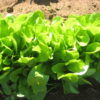Summer may be in full swing, but that doesn’t mean it’s too late to plant. In fact, several crops thrive in the heat and mature quickly enough to beat fall frost, even when started in June or July. Whether you’re filling empty rows or just getting started, these heat tolerant vegetables, herbs, fruit, and flowers are reliable performers—all available from St. Clare Heirloom Seeds.
Table of Contents
Here are 11 heat tolerant crops you can still plant from seed during the hottest part of the growing season.
1. Okra
Days to Maturity: 50–60 days
Okra thrives in the heat and is practically made for July planting. Varieties like Clemson Spineless and Red Burgundy grow quickly and produce tender pods perfect for frying, stews, or pickling. Okra needs full sun and warm soil to germinate, and the more you harvest, the more it produces.
Tip: Soak seeds overnight before planting to speed germination. Harvest pods when 3–4″ long for best texture.
2. Cowpeas (Southern Peas)
Days to Maturity: 60–70 days
Also known as black-eyed peas or cream peas, cowpeas handle heat, humidity, and even drought. They’re ideal for the Southeast, lower Midwest, and southern Plains. They fix nitrogen in the soil and can be used green or dry.
Tip: Direct sow in full sun. Bush types are best for quick harvests; trellis vining types if space allows.
3. Basil
Days to Maturity: 45–60 days
Basil loves summer heat and grows fast from seed. Genovese, Lemon, and Thai basil varieties from St. Clare are all quick to germinate and productive through hot weather. Regular harvesting delays flowering and boosts yield.
Tip: Sow in succession every few weeks for fresh leaves through fall. Pinch flower heads to keep leaves coming.
4. Malabar Spinach
Days to First Harvest: 55–65 days
While not a true spinach, Malabar spinach is a vining green that thrives in tropical heat. It’s perfect for southern zones and humid climates where leafy greens usually fail. The leaves can be eaten raw or cooked and continue growing until frost.
Tip: Provide a trellis and harvest young leaves regularly. In cooler zones, start seeds indoors to get a jump.
5. Lemon Queen Sunflower
Days to Bloom: 70–80 days
This fast-growing heirloom sunflower not only tolerates heat, it loves it. Lemon Queen grows quickly and flowers by early fall if planted mid-summer. It’s a favorite of pollinators and adds cheerful, golden color to any garden bed.
Tip: Sow directly in full sun. Space 12–18″ apart. Water until established, then it’s drought-tolerant.
6. Black Beauty Zucchini
Days to Maturity: 50–60 days
Zucchini may struggle in late summer due to squash bugs and borers—but fast-growing Black Beauty gives you a shot at a strong harvest before pests peak. When planted in June or July, it often avoids early-season pest pressure and still yields heavily.
Tip: Sow directly in warm soil and harvest fruits at 6–8″ for peak flavor. Mulch to conserve soil moisture.
7. Crimson Sweet Watermelon (for Warmer Zones)
Days to Maturity: 80–85 days
If you’re in Zones 6b or warmer, you can still start a late crop of watermelon. Crimson Sweet matures in about 80 days and is known for sweet, juicy flesh and heat tolerance. It needs space and sun, but rewards the effort with a late-summer harvest.
Tip: Start with pre-warmed soil and keep vines evenly watered. In Zones 5–6a, try a smaller variety like Sugar Baby (75 days).
8. Lacinato Dinosaur Kale
Days to Maturity: 65–75 days
Also known as Tuscan or Dinosaur Kale, this Italian heirloom produces dark, blue-green leaves with a crinkled texture and rich, earthy flavor. Though often grown for fall, Lacinato kale can be sown in midsummer for a fall harvest and tolerates heat surprisingly well when given consistent moisture and some afternoon shade. It’s slow to bolt and grows upright, making it great for smaller gardens.
Tip: Sow directly or transplant starts about 8 weeks before your first expected frost. Mulch well to retain moisture and harvest the outer leaves when 8–10″ long. Plants become sweeter after light frost.
9. Green Wave Mustard Greens
Days to Maturity: 45–55 days
A fast-growing Southern favorite, Green Wave mustard greens are highly heat-tolerant and slow to bolt, making them ideal for midsummer sowing. Their frilled, bright green leaves pack a peppery bite raw and mellow out when cooked. This heirloom performs reliably in both hot and cool weather, offering flexible timing for multiple harvests.
Tip: Sow directly in full sun or partial shade. For continuous harvest, sow every 2–3 weeks. Pick young leaves often to encourage new growth and keep plants tender.
10. Red Garnet Amaranth
Days to Maturity: 40–60 days for greens
Amaranth thrives in high heat and poor soil, making it one of the best leafy greens for summer planting. Red Garnet produces vivid reddish-purple leaves that can be harvested young for salads or cooked like spinach. Left to grow, the plants develop tall, dramatic flower spikes and edible seeds by fall.
Tip: Sow seeds directly in warm soil and do not cover deeply—they need light to germinate. Harvest baby leaves regularly or let some plants mature for ornamental seed heads.
11. Champion Collard Greens
Days to Maturity: 60–80 days
Collards are known for their hardiness, and Champion is especially valued for its heat tolerance and bolt resistance. This variety produces broad, blue-green leaves with a mild flavor, perfect for sautéing, braising, or chopping into soups. Summer-sown collards mature in fall and improve in taste after a light frost.
Tip: Direct sow in mid to late summer for a fall crop. Space plants well and keep evenly watered for best growth. Harvest outer leaves as needed for continuous yield.
Discover What Gardeners Are Saying About Our Seeds!
Bonus Tip: Choose Fast Maturing Varieties
When planting heat tolerant crops in midsummer, timing is everything. Even the most heat tolerant crops need to mature before fall frost, so choosing fast maturing varieties with short growing seasons is key. Focus on crops that mature in under 80 days, with some like basil, okra, and zucchini ready in as little as 50–60 days. This gives you flexibility even in regions with shorter summers.
Look for heat tolerant crops that are also fast maturing, and don’t overlook those that can be harvested at different stages—for example, squash picked young or greens harvested continuously. In colder zones (like Zones 4–6), that extra buffer between maturity and frost is critical.
Starting with warm soil, full sun, and regular watering will help you hit maturity dates more reliably. With the right planning, you can enjoy a productive second harvest even in the heat of summer.
Tips for Growing in Summer Heat
- Choose heat tolerant varieties: Opt for varieties that are specifically bred or widely recognized for their ability to thrive in hot, dry conditions. These heat tolerant crops are well suited for growing in summer heat, where they can withstand high temperatures, intense sunlight, and occasional dry spells. Choosing the right varieties not only boosts your garden’s productivity but also makes growing in summer heat more successful, even during the most challenging parts of the season.
- Provide shade: Especially during the hottest part of the day, provide some shade to prevent wilting and heat stress, particularly for tender greens and young seedlings. Even heat tolerant crops can benefit from filtered light or temporary shade structures when temperatures soar. Using row covers, shade cloth, or planting near taller crops can help reduce leaf scorch and moisture loss. When growing in summer heat, protecting your plants from direct, midday sun can make the difference between a thriving garden and one that struggles to survive. Thoughtful shading is a simple but effective way to support healthy growth during peak heat.
- Water regularly: Ensure consistent moisture, as heat can cause plants to dry out quickly and place them under unnecessary stress. Irregular watering during high temperatures can lead to problems like blossom end rot, bolting, or reduced yields—especially in fast-growing crops. A deep, steady watering routine encourages strong root systems and helps plants remain resilient during temperature spikes. When growing in summer heat, it’s especially important to monitor soil moisture closely, as evaporation happens faster and roots can dry out before you notice signs of stress above ground. Watering early in the morning or late in the evening, when temperatures are cooler, helps reduce loss to evaporation and ensures your heat tolerant crops have access to the moisture they need throughout the day.
- Mulch: Mulching helps retain soil moisture and keeps roots cool, both of which are essential when growing in summer heat. A thick layer of organic mulch—such as straw, shredded leaves, grass clippings, or compost—acts as a protective barrier, reducing evaporation and regulating soil temperature during hot days. This is especially important for shallow-rooted crops and young seedlings, which are more vulnerable to drying out. Mulch also helps suppress weeds that compete for water and nutrients, while improving soil structure and microbial activity over time. When growing in summer heat, maintaining a steady layer of mulch can significantly boost plant health, reduce watering needs, and create more stable growing conditions across your garden.
- Succession planting: Sow seeds every few weeks to ensure a continuous harvest, especially for quick-growing greens like mustard, amaranth, or basil. This technique, known as succession planting, allows you to stagger your harvests and avoid gaps in productivity during the season. It’s particularly effective when growing in summer heat, as some crops may bolt or become bitter if left too long in high temperatures. By planting in intervals, you can maintain a steady supply of fresh, tender leaves and young vegetables even as older plants begin to decline. Succession planting also helps reduce the impact of pests or weather fluctuations, ensuring that at least some of your crops are always at their peak. When timed carefully, this approach can keep your garden productive and full of variety all the way through the hottest weeks of the season.
Final Word – Make the Most of Summer with Heat Tolerant Crops
High summer is far from the end of gardening—it’s an opportunity to make the most of the season’s warmth. This time of year can be ideal for squeezing in a quick second crop, reviving worn-out beds, or experimenting with new varieties that thrive under high temperatures. Even small successions—just a few rows of basil, a patch of okra, or a handful of fast-maturing greens—can yield a surprising amount of fresh food before fall.
Many of these heat tolerant crops are perfectly suited to growing in summer heat, when other plants may struggle, and they often face fewer pest and disease problems than spring-sown varieties. With the right selections, your garden can stay productive and rewarding deep into the season.
Gardening in midsummer can feel different—faster paced, more intentional, and deeply rewarding. Whether you’re in the Deep South, Midwest, or high-altitude West, there’s still time to grow something flavorful, beautiful, and productive before frost. Browse our seeds at St. Clare Heirloom Seeds and get planting. It’s not too late!
What are your thoughts? Drop a comment below!
FAQ:
Can I really start seeds in July or August and still get a harvest?
Yes! Many heat tolerant crops—such as okra, basil, zucchini, and mustard greens—are fast maturing varieties that thrive when growing in summer heat. These crops often mature in under 60 days, making them perfect for sowing in mid to late summer and harvesting before the first frost, even in regions with a shorter season.
How do I know if a variety is heat-tolerant?
Look for varieties labeled as “heat-tolerant,” “slow to bolt,” or those that originate in warm climates, as they’re better adapted to growing in summer heat. The varieties featured in this article were specifically selected for their ability to thrive under hot conditions and continue producing when many other crops begin to struggle. Choosing the right heat tolerant crops makes a big difference in maintaining a productive garden through midsummer.
What’s the best way to keep seeds from drying out during germination in hot weather?
Keep the soil consistently moist by watering daily—and sometimes even twice a day during extreme heat. When growing in summer heat, rapid evaporation and intense sun can dry out the topsoil quickly, stressing young plants and seedlings. Using a light layer of mulch or shade cloth helps reduce water loss, prevent soil crusting, and keep root zones cooler, giving your heat tolerant crops the steady moisture they need to thrive.
What zone do these recommendations apply to?
These crops are adaptable across most U.S. zones. Some (like watermelon or Malabar spinach) are best suited for Zones 6 and up, but most options will thrive anywhere summer heat is present.
Can I grow leafy greens in summer?
Yes—if you choose heat-tolerant greens like Malabar spinach, amaranth, mustard greens, kale, and collards. These varieties won’t bolt as quickly and can be harvested repeatedly.
Do I need to start these indoors or can I direct sow?
Most of these heat tolerant crops can be direct-sown into warm soil, making them ideal for growing in summer heat. The high soil temperatures help speed up germination and early growth. In northern zones, or for longer-maturing varieties like kale and collards, starting seeds indoors can give you a valuable head start and help ensure they reach maturity before the first frost. This flexible approach lets you make the most of your growing season, whether you’re sowing directly or transplanting later.
How often should I water in summer?
Generally, water deeply 2–3 times a week, but daily watering may be needed during heatwaves or when establishing seedlings. Mulching helps reduce the frequency by holding in moisture.
How late in the season can I plant?
Count backward from your average first frost date using the crop’s maturity time. For example, if your first frost is October 10 and a crop takes 60 days to mature, plant by early August.
Will these crops grow in containers?
Yes—many of them can. Basil, mustard greens, kale, and even dwarf okra can do well in large pots. Just be sure containers are deep enough, don’t dry out too fast, and are placed in full sun.
Should I fertilize summer plantings?
Yes. Fast-growing summer crops benefit from a balanced fertilizer or compost-enriched soil. Greens especially need nitrogen, while fruiting crops like zucchini and watermelon benefit from phosphorus and potassium as they begin to flower.























